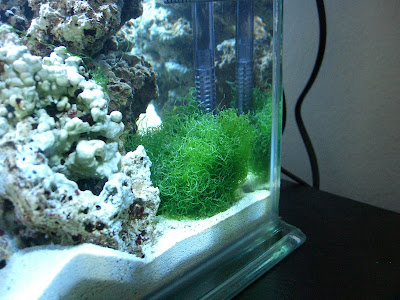
With all the equipment and supplies in place, the only thing I was missing was live rock which I was determined to find a good supply today so that I can setup the tank as soon as my homemade seawater was ready to use.
Last night I did some research online on local fish stores and I found one that I thought was worth visiting based on the costumer reviews that I read. The store is called Atlantis Tropical Fish & Aquariums. When I got there I was really impressed by the store and their wide selection of livestock. All their fish looked healthy and all their tanks were nice and clean. I made my way towards their corals/invertebrates area and was slightly disappointed when I couldn’t find any live rock stocked in any of their tanks.
So I asked one of the guys if they carried any live rock and was caught by surprise when I was escorted all the way to the back of the store into a storage room where they kept a vat full of rocks. I was elated by what I saw: mounds of cured Fiji live rock. They came in all sorts of shapes and sizes and all had good coloring and pleasant smell (unpleasant smelling live rock is usually a bad sign). The owner of the store himself even helped me pick out the rocks I need base on my project and was very helpful and friendly. He placed them in a styrofoam box and covered them with wet newspaper to prevent them from drying and to minimize die-off. I walked away with 6 lbs. of Fiji live rock (four rocks altogether) for $40. Not a bad price at all.
These are the four pieces of liverock I came home with:

Note the healthy coloring and the clusters of coralline algae.

I inspected the rocks carefully, removing any unwanted and dead pieces that could possibly rot in my tank. I gave them a good rinsing and prepared them for the tank. Aquascaping turned out to be a little difficult especially with such a small tank and I had to do this quickly as to not keep the rocks out of water for too long. Plus I think I took home one rock too many. Nonetheless I figured out the best configuration that created open areas between the rocks for good circulation as to avoid any dead spots.



Once I had the ideal configuration I filled the tank halfway with my seawater and added the live sand. I added the live sand after I laid out the live rock to make sure the rocks are grounded firmly on the tank floor. I used a small plastic cup to slowly add the sand around the rocks, making sure not to cover any part of the rocks which could clog up the rock and increase the die-off rate in my tank during the cycling period. This became even harder as the water became cloudy and I was literally working in the dark.


An hour later the tank started to clear up and have already found a couple of hitchhikers in my live rock—a hermit crab and a snail. This starts the cycling period which means I’ll have to wait before I can add anything in my tank. The bottle of Bacardi to the right will help me through this waiting period.

As far as cycling, most people turn off their lights and encourage die-off which is referred to as hard cycling. Since my live rocks are already cured, I don’t anticipate a large amount of die-off and decided to do a soft cycle with a 12-hour photoperiod each day. However I won’t be doing any water changes just yet and have decided to just let the ammonia spike up to speed up the nitrogen cycle. I will check my parameters halfway through the week and see where I’m at. For now, I shall wait.





































